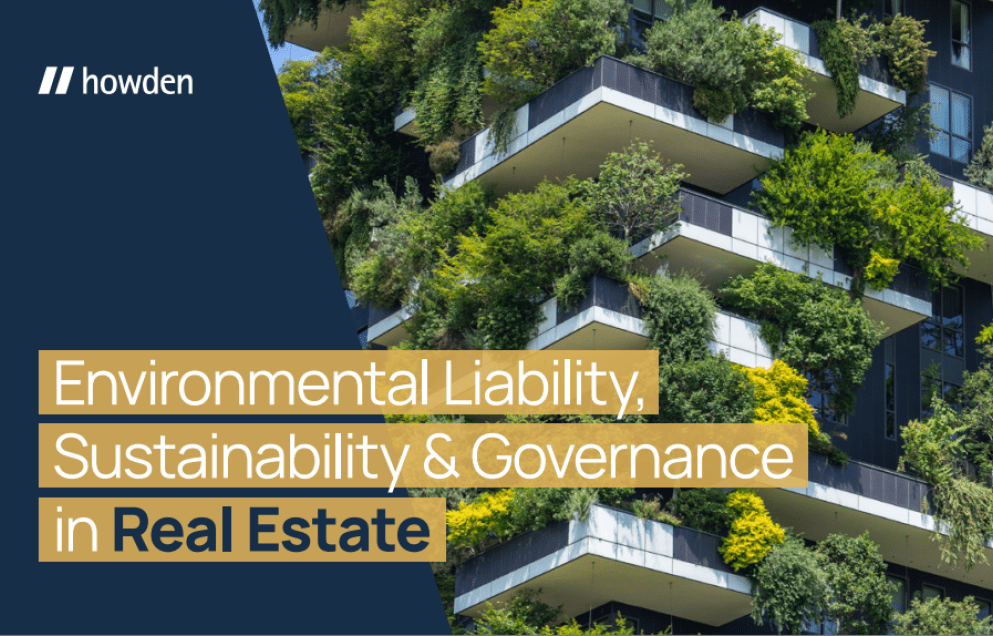Environmental Liability, Sustainability & Governance in Real Estate June 2023
Published
Read time
Environmental (E), Sustainability (S) and Governance (G) challenges in the Real Estate sector have moved from a compliance tick box exercise to something of greater importance.
Driven by lower margins, increased interest rates, inflation, decarbonisation regulation such as MEES and EPC, biodiversity, weather volatility and changes in occupancy demand post the COVID pandemic, the development and ownership of Real Estate has never been more challenging.
Real Estate stakeholders will continue to be impacted by these ESG matters. This article focuses on the current trends impacting Environmental Liability and emerging concerns.
In May 2021, the European Commission launched its Zero Pollution Action Plan – a cornerstone of the European Green Deal(1). The plan aims to reduce all air, water and soil pollution to levels no longer harmful to health and ecosystems by 2050. The Commission has proposed even stronger rules against air, surface and groundwater pollutants, including stricter controls on 25 substances found to impact nature and human health(2), reducing the threshold for “acceptable” levels of contamination. 2.5 million potentially contaminated sites exist in the EEA – the burden for remediating these sites and (as we will explain) improving them beyond previous standards, may fall on property investors and developers.
In the UK, an update of the Environment Act 2021 set to come into force later this year, will trigger a requirement for all new property developments to produce a 10% net gain in biodiversity. A key metric in calculating the biodiversity “value” of a piece of land is habitat condition – how well can the habitat function, compared to the same habitat in working order?(3) For an ecosystem to perform its essential services (natural decontamination, carbon sequestration), it needs to be free of contamination which might harm the health of the system(4). As such, contamination management is likely to factor into biodiversity net gain targets, restoring habitats to a functioning state and producing a long-term benefit for the environment and society.
Increased concern around contamination and biodiversity converge in the real estate market, where both investors and developers are expected to be impacted. Against this backdrop of increased regulation, emerging contamination and greater responsibility, Environmental Risk will be top of management’s thinking. Furthermore, the ability to de-risk environmental damage exposure can secure preferential debt terms. This can make the difference between a real estate transaction being viable.
Environmental Liability Insurance
Insurance can help you mitigate your environmental risk by transferring liability for pollution remediation, damages and crisis mitigation costs to an insurer. Provision can also be made to protect the interests of lenders.
In the first instance, environmental law works on the basis of “the polluter pays principle” – in other words the person or organisation who caused the pollution is liable for it. However, where the polluter cannot be identified, no longer exists or does not have the solvency / covenant strength to pay a claim, the current owner of the site can be held liable for pollution caused prior to their ownership of a property. In practice, this means that liability for clean-up costs and third party damages can fall on site owners, even where they have not caused the pollution.
Environmental Liability Insurance typically includes:
• Cost of cleaning up pollution, including costs and expenses incurred by the regulator which you are required to pay
• Claims for third-party bodily injury and property damage
• Biodiversity Damage Costs, including liability imposed by the European Liability Directive (2004/35/EC) and UK equivalent
• Legal defence costs
• Emergency response costs
• First-party Business Interruption Costs
In contrast to typical property damage and liability policies with a pollution extension, Environmental Liability Insurance responds to both sudden and accidental pollution, and gradual pollution, which is often uninsured under traditional policies.
About Howden’s Environmental Team
Howden’s team of Environmental Insurance experts can assess the need for insurance for Real Estate clients and work with the market to design bespoke policy solutions.
Formed in 2018, Howden’s Environmental Team consists of environmental insurance professionals across UK and Europe. In 2022, the team placed one of the largest environment policies ever, with a total limit of $150m. Working with Howden’s Real Estate team we are seamlessly able to deliver holistic solutions to meet property ownership.
Download our report here.
References:
1 - Zero Pollution Action Plan. European Commission, 2021
2 - European Green Deal: Commission proposes rules for cleaner air and water. European Commission, 2022
3 - Biodiversity Net Gain. Natural England, 2022
4 - Pathway to a Healthy Planet for All. EU Action Plan: ‘Towards Zero Pollution for Air, Water and Soil’. European Commission, 2021
